Plug 'n Power
Plug ‘n Power was Radio Shack’s brand name for products that used the X10 power line communications protocol. X101 was developed in 1975 by Pico Electronics, Ltd. of Glenrothes, Scotland. Radio Shack, along with Sears, Roebuck & Co. (with the Sears Home Control System) and BSR (with the BSR System X-10), was among the first sellers of X10 compatible products.
Radio Shack introduced their first Plug ‘n Power products in late 19792. Most of the products were appliance and light modules. These plugged into an electrical outlet, and an appliance or light was then plugged into the module. Some of those modules included:
- Appliance Module (catalog number 61-2681) cost $16.99 (originally $15.99)
- Lamp Dimmer Module (catalog number 61-2682) cost $16.99 (originally $15.99)
- Universal Appliance Module (catalog number 61-2684)3 cost $17.99
- Wall Switch Module (catalog number 61-2683) cost $17.99
- Wall Outlet Module (catalog number 61-2685) cost $21.95
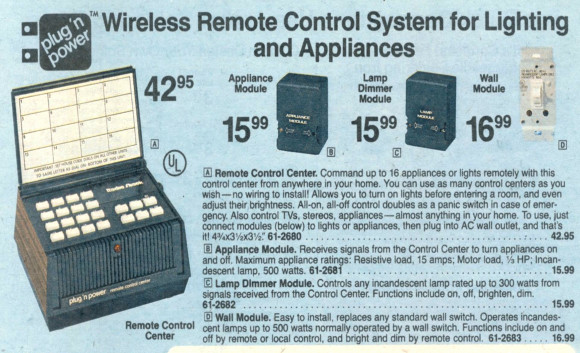
Plug ‘n Power devices from a 1981 Radio Shack catalog
The modules were designed to respond to commands sent over the electrical wires inside the house. They could turn on or off, or in the case of a lamp, change brightness. The advantage of using a power-line communication system was that it didn’t require any additional (and costly) signal wiring.
To control the devices, Radio Shack sold the Plug ‘n Power Remote Control Center (catalog number 61-2680) for $42.95. It was fairly small, measuring 4 3/4" by 3 1/2" by 3 1/2". Like the other Plug ‘n Power modules, it just needed to be plugged into an electrical outlet to work.
As an example, you could plug a television into an Appliance Module and a lamp into a Lamp Dimmer Module. You could then plug in a Remote Control Center anywhere in the house and use the buttons to turn the television on or off and adjust the lamp brightness.
The TRS-80 Plug ‘n Power Controller
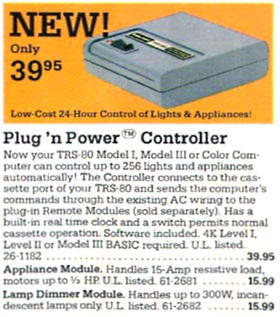
TRS-80 Plug ‘n Power Controller from a 1981 Radio Shack catalog
Like the Remote Control Center, the Plug ‘n Power Controller used the electrical wiring to send control signals to Plug ‘n Power modules. Unlike the Remote Control Center, the Plug ‘n Power Controller connected directly to a TRS-80 computer using the cassette port. This meant that up to 256 Plug ‘n Power devices could be controlled directly from a TRS-80 using software.
From a 1981 Radio Shack Computer catalog:
Control up to 256 lights and appliances with your TRS-80 Model I, III, or Color Computer. Activate security lights, start dinner, turn on the radio and much more — all from one central location! Nothing to install — just plug appliances into modules, and then into AC outlet and you’re all set.
One nice feature of the Plug ‘n Power Controller was a port to plug in a cassette recorder, coupled with a switch on the top of the unit with two settings: “CTRL” and “CASS”. Changing the switch to “CASS” allowed the TRS-80 to read from the cassette recorder normally. Changing the switch to “CTRL” allowed the TRS-80 to control the Plug ‘n Power devices.
Software for the Plug ‘n Power Controller came on two cassettes, with versions for the Model I, Model III, and Color Computer. There were also program listings in the 36-page manual.
The disadvantage of the Plug ‘n Power Controller was that the TRS-80 had to be turned on and running the appropriate software to control the Plug ‘n Power devices. This meant that a complete home automation system needed to have a TRS-80 permanently devoted to it.
In 1983, Radio Shack reduced the price of the Plug ‘n Power Controller to $19.95. It remained at that price until it sold out.
The TRS-80 Color Computer Appliance/Light Controller
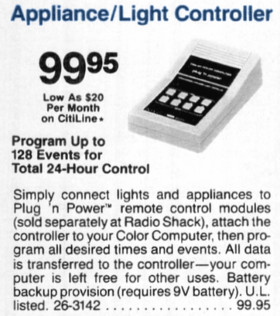
TRS-80 Color Computer Appliance/Light Controller from a 1986 Radio Shack catalog
Instead of a cassette connection, the Appliance/Light Controller attached to the Color Computer using the serial port.4 Unlike the Plug ‘n Power Controller, the Appliance/Light Controller didn’t use the TRS-80 to directly control appliances. The included ROM Pak software could program events into the Appliance/Light Controller, but that was the end of the computer involvement. The Appliance/Light Controller would turn appliances and lights on and off according to a schedule and without dedicating a computer to the task.
One quirk of the Appliance/Light Controller software was that it used an undocumented Color Computer video mode. This mode wasn’t one that Radio Shack supported when they created the Color Computer 3 later. The Appliance/Light Controller software was one of the few Color Computer 1/2 programs that wouldn’t run on the Color Computer 3.
Although Radio Shack didn’t sell any more TRS-80-based Plug ‘n Power hardware, they did continue to sell and introduce new Plug ‘n Power devices. In fact, there were three pages of Plug ‘n Power items in the final Radio Shack catalog in 2002. Radio Shack no longer sells Plug ‘n Power devices5, but X10 compatible devices such as Appliance Modules, Lamp Control Modules, and Wall Switch Modules are still sold today.
-
X10 was the tenth project developed at Pico Electronics. ↩︎
-
Many sources identify Plug ‘n Power as having been introduced in 1978, but Radio Shack gave a date of first use as September 1979. ↩︎
-
The difference between the Appliance Module and the Universal Appliance Module was that the Appliance Module could control appliances with two-prong electrical plugs but the Universal Appliance Module could handle appliances with two- or three-prong plugs. ↩︎
-
The Appliance/Light Controller was a revised version of a Mattel Aquarius X10 interface that Pico Electronics never released. They revised it again into the CP290, which became the standard X10 controller for non-TRS-80 computers. ↩︎
-
Radio Shack’s Plug ‘n Power trademark was cancelled in 2010. ↩︎
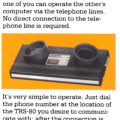
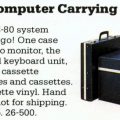
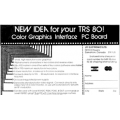
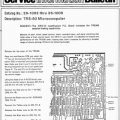










Doug Anderson says:
Since I worked while in high school, all of my income was disposable and went to Radio Shack. I bought a pair of these modules to play with and hooked up the controller to my Model III. My first challenge was to install them onto our living room lights without my parents knowing. I waited until Dad came home from work. While in my room at the computer, I started to cycle the lights off and on. It didn’t take him long to figure it out, but we still had a good laugh.
Dan says:
I found this article while looking how to control my appliance/light controller with a custom-made cable and vba code. I still have my first computer (color computer II) and plugged it in on 11/30/16 programmed my appliance modules to cycle my christmas lights. Still looking for a way to send commands from my pc via rs-232.
Wolfgang Koecher says:
very interesting , thank you. I wish I could still purchase some switch-modules. There is lots of receptacle remote controls for sale, but the switch ones are more practical. I use them for the Cottage to Boathouse Appliances.